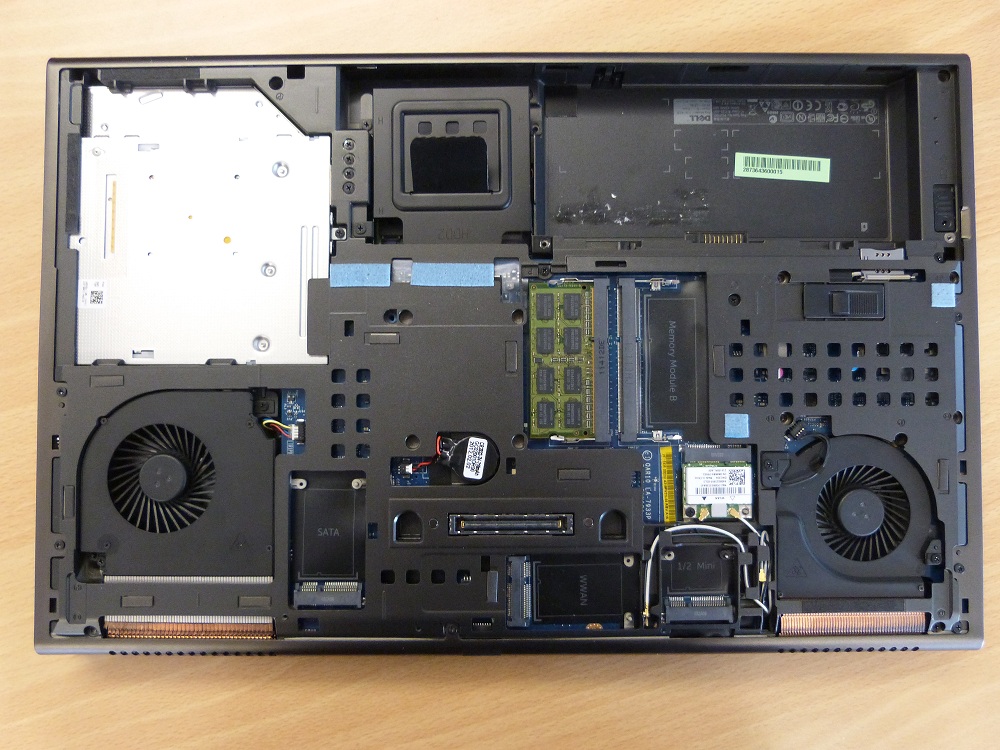Dell Precision M6700 review
This 17in workstation features an robust design, plenty of ports and can be configured to suit your business needs.
Dell’s 17in workstation doesn’t come cheap, especially if you improve its specification with the wealth of upgrades available. However, it’s a price worth paying for those who need desktop-style power in a machine that can be slung onto the back seat of a car. The M6700 has few weaknesses: stellar build quality, more versatility than most desktops, good performance and a screen which is only really beaten by Apple. The MacBook Pro is tempting thanks to its screen quality and power, but the Precision’s versatility, features and upgrade options mean this should be the choice for anyone looking to do serious work.

Clever on the inside
The M6700 is one of the most modular laptops we've ever seen, in contrast other devices such as the MacBook Pro, which offers no upgradeable parts. After removing the battery and screws, the bottom slides out of the way, and there's plenty to like on the inside. There are two memory slots, one of which is occupied on our review sample, and both of the cooling fans can be removed quickly.
There's plenty of room to expand: spare mini-PCI Express and mSATA sockets can be used for improved Wi-Fi chips or additional storage, and the existing wireless card is slotted into a half-height mini-PCI Express socket, with a spare one alongside.

The life of the device can be extended by upgrading parts as and when required
Dell has paid attention to the tiniest detail, with even four screws provided to fit extra parts. These sit alongside an empty hard disk cage. Holes for screws are identified with letters based on which parts they connect to, and it's possible to easily remove the shroud covering most of the motherboard as it stretches across the machine. The hard disk, meanwhile, pops out of its own socket on the right-hand side of the base and is unlocked by flicking a switch underneath the battery.
Performance
Our review sample was fitted with modest specifications. Processing power was provided by the Core i5-3320M, a mid-range Intel Ivy Bridge chip running at 2.6GHz with a maximum Turbo Boost of 3.3GHz. It scored 0.68 in our benchmark, so it has enough grunt to handle commonly used work applications - but it'll balk when tasked with resource hungry software. Those looking for more power might consider the MacBook Pro, which scored 0.92 thanks to its Core i7 processor.
Graphical power is middling, too. The AMD FirePro M6000 is a reasonable workstation chip - after all, it's based on the Radeon HD 7870M - and it scored 33fps in our 1,920 x 1,080 high quality Crysis test. This'll translate to fine performance in graphical applications, and it's also a frame quicker than the Apple's consumer graphics chip managed.
Elsewhere, there's 4GB of RAM, a DVD writer and a 320GB hard disk. The inclusion of single-band wireless is a disappointment alongside Gigabit Ethernet, but the battery improved the situation: the nine-cell powerpack on offered lasted 5hrs 27mins, which is two hours longer than the 2010 version of the Precision. This compares well to the MacBook Pro's 4hrs 32mins in Windows, but trails when compared to OS X. When running its native OS, the MacBook Pro lasted 10hrs 34mins away from the mains.
Several useful software applications are included, but Dell's packages can't match the extensive suite of apps included on Lenovo's ThinkPads. Backup, data encryption and wireless configuration tools are included, and we're pleased to see ISV certification, which guarantees plenty of business software will work without any issue.
Get the ITPro daily newsletter
Sign up today and you will receive a free copy of our Future Focus 2025 report - the leading guidance on AI, cybersecurity and other IT challenges as per 700+ senior executives
Mike Jennings has worked as a technology journalist for more than a decade and has been fascinated by computers since childhood, when he spent far too long building terrible websites. He loves desktop PCs, components, laptops and anything to do with the latest hardware.
Mike worked as a staff writer at PC Pro magazine in London for seven years, and during that time wrote for a variety of other tech titles, including Custom PC, Micro Mart and Computer Shopper. Since 2013, he’s been a freelance tech writer, and writes regularly for titles like Wired, TechRadar, Stuff, TechSpot, IT Pro, TrustedReviews and TechAdvisor. He still loves tech and covers everything from the latest business hardware and software to high-end gaming gear, and you’ll find him on plenty of sites writing reviews, features and guides on a vast range of topics.
You can email Mike at mike@mike-jennings.net, or find him on Twitter at @mikejjennings
-
 Google breakup plans would ‘hurt America’s consumers, economy, and technological leadership’, senior exec claims
Google breakup plans would ‘hurt America’s consumers, economy, and technological leadership’, senior exec claimsNews Google has struck back against US regulators, claiming that plans to dismantle the company would "hurt the economy".
By Nicole Kobie Published
-
 InfoComm 2025 Best of Show Awards are now open for entries
InfoComm 2025 Best of Show Awards are now open for entriesSubmissions are open until the closing deadline of May 30
By ITPro Published
-
 M&S calls in NCSC after 'cyber incident' disrupts customer payments, online orders
M&S calls in NCSC after 'cyber incident' disrupts customer payments, online ordersNews Retail giant Marks & Spencer (M&S) has revealed it has been dealing with a “cyber incident” in recent days and apologized to customers amid disruption complaints.
By Ross Kelly Published